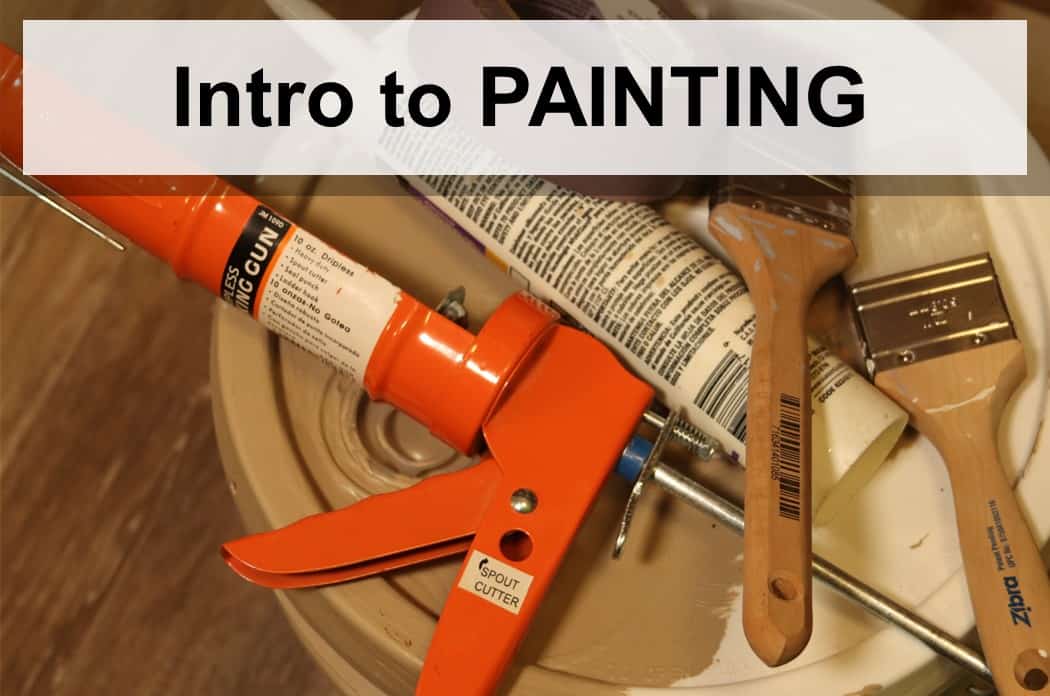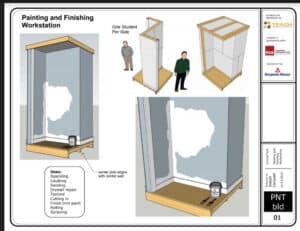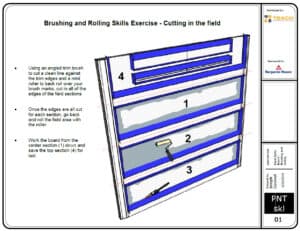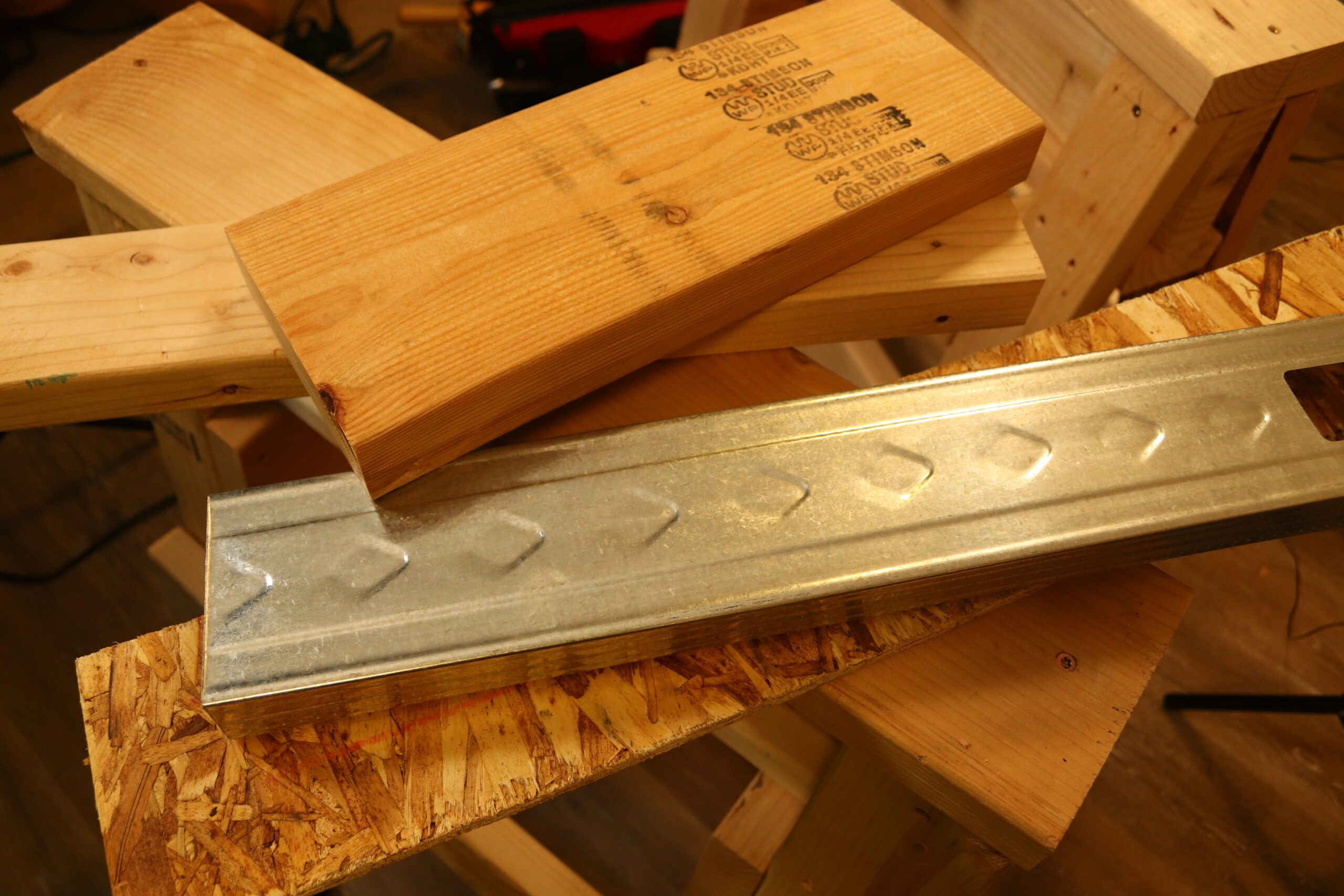Painting Resources
Modules Below:
-
- Materials
- Caulking
- Spackling
- Taping and Masking
- Sanding
- Brushes
- Rollers
Click here to view course and content description
Thanks to the sponsorship support from Benjamin Moore – you and your students can access the course for no cost.
https://youtu.be/ikPobYoGbVc
Materials Module
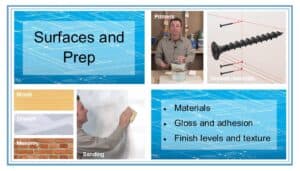
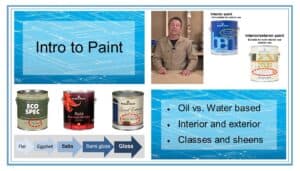
Welcome
Resource Links
Learning Objectives
Competencies
Welcome
Click a tab to show content
Resource Links
Lesson Videos
https://teachlink.online/Basics-and-Paint
https://teachlink.online/Substrate-Materials
Presentation Slides
https://teachlink.online/Painting-surfaceprep-slides-TSUversion
https://teachlink.online/Painting-intro-slides
Vocabulary
https://teachlink.online/Painting-materials-vocab
Knowledge Review
https://teachlink.online/Paint-and-coating-quiz
https://teachlink.online/painting-surface-prep-quiz
Answer Key – Send email to request access
https://teachlink.online/Painting-materials-surfaceprep
Skills Exercise
N/A
Learning Objectives
Intro to Paint
This lesson introduces paints as a mainstay material for painters and stresses the importance that quality makes in product performance and application. The different classes of paints will be covered as well as their purpose in the painting process. Differences between oil and water-based paints will be compared to include the pros and cons of each. Sheens and terms to identify them will be explained as well as pros and cons of each. The properties of various paint families will be presented and common uses for each. Paints will be categorized as a hazardous waste and the potential health hazards related to exposure and handling will be discussed as well as proper disposal.
Student Learning Objectives:
• Students will gain an understanding of the pros and cons of oil and water-based paints as these two major paint categories are compared.
• Students will receive information about the properties of different families of paints to
include:
-
- Latex
- Alkyd
- Epoxy
- Urethane
• Students will understand the concept of paint sheen and how it affects the way the paint appears and performs as well as common areas where each can be used effectively
Competencies
11.5 Solid Coatings – Demonstrate knowledge of common solid coatings and their use
These competencies are from Building Credentials for Construction – to learn more about BCC click here
Caulking Module
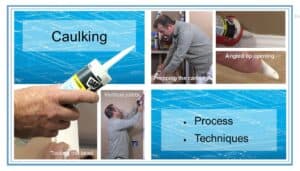
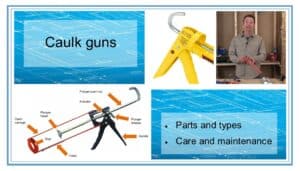
Welcome
Resource Links
Learning Objectives
Competencies
Welcome
Click a tab to show content
Resource Links
Lesson Videos
https://teachlink.online/Caulking-parts-and-types
https://teachlink.online/Caulking-Process
Presentation Slides
https://teachlink.online/caulking-parts-slides
https://teachlink.online/Caulking-process-slides
Vocabulary
https://teachlink.online/Caulking-vocab
Knowledge Review
https://teachlink.online/Painting-Caulking-Quiz
Answer Key – Send email to request access
Skills Exercise
https://teachlink.online/Caulking-Skills-Exercise
Learning Objectives
Caulking Tools
Overview:
This is the first lesson in caulking and it introduces caulk guns as important tools for painters and delves into the different parts of a caulk gun as well as types that are available.
Basic operation of a caulk gun is covered including cartridge loading, trigger action, and pressure release
Information about care of caulk guns to include cleaning, handling and storage will be taught with a focus on best practice for longevity and long-term performance of the tool
Student Learning Objectives:
• Students will learn the different parts of caulk guns and the terms used to describe them.
• Students will learn variations of caulk guns available and the advantages of each.
Caulking Process
Overview:
This lesson introduces various techniques used with caulk guns to create professional results. Holding the caulk gun properly and physically manipulating the tool will be emphasized as well as other concepts that explain how to effectively transfer the caulk from the gun to a seam to create a clean bead.
Student Learning Objectives:
• Students will learn the correct way to hold a caulk gun and position it for best bead application
• Students will learn the correct way to add and release pressure to the gun to apply a consistent caulk bead
• Once applied students will practice tooling the bead it to an acceptable finish
• Students will learn the process of cleaning, handling, and storing caulk guns and cartridges
Competencies
11.11 Caulking – Demonstrate knowledge and proper use of tools and materials to apply
sealants
These competencies are from Building Credentials for Construction – to learn more about BCC click here
Spackling Module
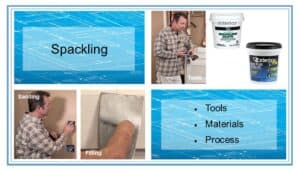
Welcome
Resource Links
Learning Objectives
Competencies
Welcome
Click a tab to show content
Resource Links
Lesson Videos
https://teachlink.online/Spackling
Presentation Slides
https://teachlink.online/Spackling-slides
Vocabulary
https://teachlink.online/spackling-vocab
Knowledge Review
https://teachlink.online/Painting-Spackling-Quiz
Answer Key – Send email to request access
Skills Exercise
N/A
Learning Objectives
Sanding
Overview:
This lesson introduces spackling as a prep process to remove minor surface defects prior to painting.
Areas suitable to apply spackle will be explained.
Different types of fillers and their ingredients are covered as well as the correct application for each.
Safety data sheet information will be introduced as related to spackle materials.
Spackle tools and the correct methods to use them while filling defects will be taught.
Included will be information related to special situations and best and worst practice when spackling
Students will also understand the process of sanding as the finishing step of spackling
Student Learning Objectives:
• Students will learn the different circumstances that warrant filling
• Students will learn the different fillers available and which works best for different applications
• Students will learn the proper tools to use when spackling
• Students will understand techniques and process for spackling that leads to a good surface for paint
Competencies
11.12 Spackle – Demonstrate knowledge and proper use of tools and materials to apply fillers
These competencies are from Building Credentials for Construction – to learn more about BCC click here
Taping and Masking Module
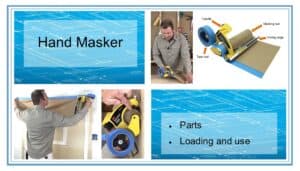
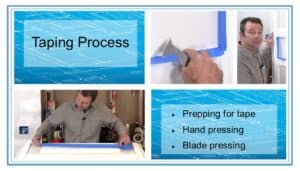
Welcome
Resource Links
Learning Objectives
Competencies
Welcome
Click a tab to show content
Resource Links
Lesson Videos
https://teachlink.online/Tape-Materials
https://teachlink.online/Tape-Materials
https://teachlink.online/Hand-Masker
https://teachlink.online/Floor-Protection
Presentation Slides
https://teachlink.online/Taping-slides
Vocabulary
https://teachlink.online/Taping-vocab
Knowledge Review
https://teachlink.online/Painting-Masking-Quiz
Answer Key – Send email to request access
Skills Exercise
https://teachlink.online/taping-skills-exercise
Learning Objectives
Taping and Masking
Overview:
Through this lesson, students will gain an understanding of the purpose and the time saving benefits of taping and masking as prep for painting. They will be introduced to various materials, tools, techniques, and best practices used when masking and taping.
Student Learning Objectives:
• Students will learn the different aspects of masking tapes and how each affects performance
• Students will learn types of masking tapes and when to use them
• Students will learn the different methods to apply tape
• Various masking materials will be reviewed, and which is best for a given scenario to include different masking papers and plastics
• Best practice masking and taping concepts that lead to clean site protection and a quality paint finish will be covered
Competencies
11.8 Taping and Masking – Demonstrate knowledge of and perform the necessary steps and methods when taping and masking surfaces in preparation for paint
These competencies are from Building Credentials for Construction – to learn more about BCC click here
Sanding Module
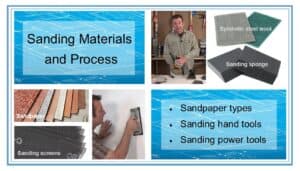
Welcome
Resource Links
Learning Objectives
Competencies
Welcome
Click a tab to show content
Resource Links
Lesson Videos
https://teachlink.online/Sanding-Tools-and-Process
Presentation Slides
https://teachlink.online/Sanding-tools-slides
Vocabulary
https://teachlink.online/Sanding-vocab
Knowledge Review
https://teachlink.online/Painting-Sanding-Quiz
Answer Key – Send email to request access
Skills Exercise
N/A
Learning Objectives
Sanding
Overview:
This lesson explores sanding as an important step of prep work before and during the painting scope. The purpose of sanding during various steps of the painting process will be covered. Hand sanding and machine sanding as well as the related tools and equipment will be covered as well as the different types of sandpaper and other sanding materials used for various jobs. Some basic techniques to use when sanding will be presented. Job hazards related to sanding will be explained as well as appropriate PPE options for
protection from airborne particulate. Workers will learn to identify different dust collection equipment and strategies and levels of vacuum filtering will be demonstrated.
Student Learning Objectives:
• Students will learn the purpose of sanding and when a painter sands in the scope of the painting process.
• Students will gain an understanding of the different grits of sandpaper and how each affects the finish.
• Students will also learn about other alternative sanding materials available and the uses of each.
• Students will understand the different types of hand sanders available and when to use each.
• Students will understand the different types of power sanders available and when to use each.
• Students will gain knowledge about the hazards related to the sanding process and how to choose the appropriate PPE to protect against airborne particulate.
Competencies
11.10 Sanding Tools – Demonstrate knowledge of and proper use of sanding tools and materials
11.4 Substrate Materials – Demonstrate knowledge of common substrate materials and surface conditions found in painting
These competencies are from Building Credentials for Construction – to learn more about BCC click here
Brushes Module
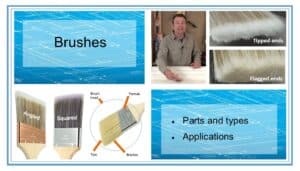
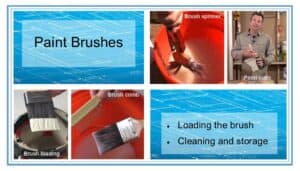
Welcome
Resource Links
Learning Objectives
Competencies
Welcome
Click a tab to show content
Resource Links
Lesson Videos
https://teachlink.online/Brush-parts-and-types
https://teachlink.online/Brush-Application
https://teachlink.online/Brush-Care
Presentation Slides
https://teachlink.online/Painting-brushes-Parts-TSUslides
https://teachlink.online/Painting-Brush-use-slides
https://teachlink.online/Painting-brush-care-slides
Vocabulary
https://teachlink.online/Painting-Brush-vocab
Knowledge Review
https://teachlink.online/Painting-brushes-quiz
Answer Key – Send email to request access
Skills Exercise
https://teachlink.online/Painting-Skills-Exercise-Cutting
https://teachlink.online/Painting-Skills-exercise-trim
Learning Objectives
Brush Parts
This is the beginning lesson for brushes and introduces them as important tools for painters and delves into the different parts of a brush and various types of brushes available including various bristle materials. Physical attributes of brushes like brush head width, thickness, and taper will also be included as well with details about how these different aspects affect brush performance.
Information about care of brushes to include cleaning, handling, and storage will be taught with a focus on best practice for longevity and long-term performance of the tool.
Student Learning Objectives:
• Students will learn the different parts of a brush and the terms used to describe them.
• Students will learn various types of brush handles available and when to use each.
• Students will learn about brush heads, their different configurations, and how various aspects of them affect performance, paint application, and finish.
• Students will be able to identify which bristle type works best with specific paint formulations
• Students will understand the aspects of a quality brush
• Students will learn the characteristics of different synthetic filaments and how they affect the performance of a brush and the finish of the paint.
• Students will learn the process of cleaning, handling, and storing brushes properly.
Brush Use
Overview:
This lesson follows “Brush Parts, Types, and Care” and introduces various techniques used with brushes to create professional results. Choosing the correct brush for different painting
situations will be explained. Holding the brush properly and physically manipulating the tool will be emphasized as well as other concepts that explain how to effectively transfer the paint
to a surface and distribute it for a smooth finish.
Student Learning Objectives:
• Students will learn the correct way to hold a brush.
• Students will be able to choose an appropriate brush for a specific task or technique.
• Students will learn the characteristics of various bristle materials and how they affect the performance of a brush and the finish of the paint.
• Students will learn the proper way to load a brush with paint
• Students will learn the correct way to apply the paint to a surface and work it to an acceptable finish for a large surface area.
• Students will learn the correct way to apply paint to a surface and work it to an acceptable finish for a smaller and/or more detailed surface area (trim)
• Students will learn the correct way to apply the paint to a surface to create a clean line or edge.
• Students will learn the process of cleaning, handling, and storing brushes properly.
Competencies
11.13 Brushing – Demonstrate knowledge and proper use of specific tools and materials when applying coatings with brushes
These competencies are from Building Credentials for Construction – to learn more about BCC click here
Rollers Module
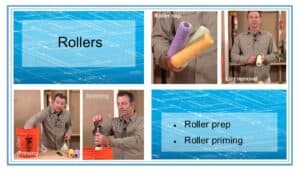
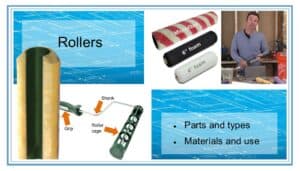
Welcome
Resource Links
Learning Objectives
Competencies
Welcome
Click a tab to show content
Resource Links
Lesson Videos
https://teachlink.online/Roller-Types-and-Parts
https://teachlink.online/Roller-Prep
https://teachlink.online/Roller-Application
Presentation Slides
https://teachlink.online/Painting-roller-parts-slides
https://teachlink.online/TSU-Painting-Roller-Use-Presentation
Old Version
https://teachlink.online/Painting-roller-parts-slides
https://teachlink.online/Painting-roller-use-slides
Vocabulary
https://teachlink.online/Painting-rollers-vocab
Knowledge Review
https://teachlink.online/Painting-Rollers-Quiz
Answer Key – Send email to request access
Skills Exercise
N/A
Learning Objectives
Roller Parts
Overview:
This is the first lesson for rollers and it introduces them as key production tools for painters and identifies the 3 main components of a roller system.
Details of each of the 4 components will be explained related to:
• Function and purpose for the task
• Quality materials and appropriate sizes needed for good performance
• Material choice and the effect on the painting task
The function of roller frames and aspects of a quality unit are discussed. Extension poles, their adjustments, and function when rolling will be covered. Information about care of rollers to include prepping, priming, cleaning, handling and storage will be taught with a focus on best practice for longevity and long term performance of the tool.
Student Learning Objectives:
• Students will learn the 4 different parts of a roller system and the terms used to describe them:
- Roller cover
- Roller frame
- Extension pole
- Tray or screen for paint transfer
Students will learn about roller cover attributes and how each affects the paint delivery final finish
- Sleeve Size (width)
- Sleeve construction (woven or knitted)
- Materials used (natural or synthetic)
- Nap length
• Students will be able to identify which roller cover works best with specific paint formulations and surface aspects
• Students will learn the process of prepping, priming, cleaning, handling and storage of rollers
Roller Use
Overview:
This lesson includes various techniques used with a roller system to create consistently professional results. Working with roller covers for different painting situations will be
explained. Holding and working the roller properly and physically manipulating the tool will be emphasized as well as other concepts that explain how to effectively transfer the paint to a surface and distribute it for a smooth finish.
Student Learning Objectives:
• Students will be able to choose appropriate roller components to paint a surface
• Students will learn the correct way to hold a roller and transfer paint from a try to a surface
• Students will learn the proper way to load a roller with paint
• Students will learn the correct way to apply the paint to a surface with a 9” roller and work it to an acceptable finish for a large surface area.
• Students will learn the correct way to apply the paint to a surface with a mini roller and work it to an acceptable finish for a smaller surface area.
• Students will learn the process of cleaning, handling, and storing rollers properly.
Competencies
11.14 Rolling – Demonstrate knowledge and proper use of specific tools and materials when applying coatings with rollers
11.15 Brush & roller care – Demonstrate ability to properly clean and store paint brushes, rollers and roller covers including the proper disposal of waste paint, solvents, and wastewater.
These competencies are from Building Credentials for Construction – to learn more about BCC click here
Exercise and Build Resources
Painting Workstation – https://teachlink.online/Painting-workstation-build
Workstation Build Notes – https://teachlink.online/painting-workstation-build-notes
Skills Board – https://teachlink.online/Painting-Skills-board

